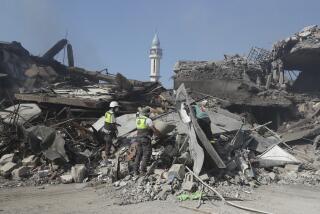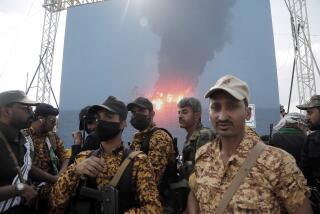U.S. steps up drone strikes against militants in Yemen
WASHINGTON â Prompted in part by a video in which Al Qaeda leaders taunted the United States, the CIA launched lethal drone strikes in Yemen that marked an escalation in the Obama administrationâs shadow war against the terrorist networkâs most powerful franchise.
Yemeni officials, who said their counter-terrorism forces carried out ground raids in conjunction with the airstrikes, reported Monday that the assaults on alleged training camps and vehicles had killed 55 militants, including some foreigners, and at least three civilians.
The majority of the deaths were said to be from the airstrikes, an unusually high toll for what U.S. officials normally describe as targeted killings. They also show that Yemen has replaced Pakistan as the focus of Americaâs drone attacks, with a total of 13 this year, compared with none in Pakistan.
U.S. officials said they had no evidence that the latest attacks had killed the top American target in Yemen, master bomb maker Ibrahim Hassan Asiri, or Nasser Wuhayshi, who is the head of Al Qaedaâs Yemeni franchise and the networkâs second-ranking leader.
Washington considers the Yemeni organization, known as Al Qaeda in the Arabian Peninsula, a serious threat because it has repeatedly launched sophisticated plots with innovative bombs designed by Asiri against Americans or U.S. targets.
Wuhayshi, a former aide to Osama bin Laden, surprised U.S. intelligence and counter-terrorism officials when he appeared in a provocative video reminiscent of pre-Sept. 11 terrorist videos that was featured on militant websites in the last three weeks.
He exhorted dozens of apparent followers at an open-air gathering in southern Yemenâs Abyan province, the area targeted by some of the weekend drone strikes. âWe must overthrow the leaders of infidelity and remove the cross and its holder, America,â Wuhayshi said.
The video showed the group celebrating the escape in February of two dozen militants from a prison in Yemenâs capital, Sana. Fighters were shown marching in the open, delivering speeches and firing celebratory gunfire. Most of the faces were digitally blurred.
âThat video was alarming to people,â a former senior U.S. diplomat said Monday. âThe visuals were a bit more than people wanted to see promoted in terms of their ability to gather the faithful and put it all up on YouTube and thumb their noseâ at the Yemeni government.
Wuhayshi, a Yemeni, was Bin Ladenâs secretary in Afghanistan in the 1990s when Al Qaeda was still relatively unknown. He later was jailed in Yemen but participated in a prison break in 2006 by several men who later founded Al Qaedaâs local affiliate.
In March, CIA Director John Brennan said Wuhayshi had been elevated to Al Qaedaâs No. 2 commander, a potential successor to leader Ayman Zawahiri, who is believed to be in Pakistan.
The CIA on Monday declined to comment on the drone strikes, referring questions to Yemeni officials, whose accounts were silent on the American role. At the White House, spokesman Jay Carney said he could not discuss specific counter-terrorism operations.
âBut we have a strong collaborative relationship with the Yemeni government and work together on various initiatives to counter the shared threat we face,â Carney said.
The CIA and the militaryâs Joint Special Operations Command have launched drone attacks against targets in Yemen since 2009. But the command was ordered to halt its strikes after Yemenâs government complained that an attack had hit a wedding party in December and killed a dozen civilians.
In a statement Monday, the Yemeni Embassy in Washington said the countryâs U.S.-trained counter-terrorism unit had carried out a successful raid Sunday night that targeted Al Qaeda operatives on a road in Shabwa, a southern province once held by the militants.
âThe operation delivers a strong message to the criminal and terror operatives that the armed forces and security personnel are ready to foil and thwart terrorist acts in any time and place,â President Abdu Rabu Mansour Hadi said, according to the statement.
U.S. analysts said the surge of attacks reflected the resilience of Yemenâs Al Qaeda affiliate and the weakness of Hadiâs government.
Al Qaeda fighters seized several towns and cities in Yemenâs southern tribal region in 2011, but a U.S.-backed military offensive drove them out in 2012. The group now operates out of remote mountain areas, often with the approval of local tribes
The Obama administration has âvery few options,â the former diplomat said. âThe Hadi government is fundamentally weak and has not been able to expand its authority in any meaningful way in these [tribal] areas.â
The Yemeni Embassy said the raid Sunday came after three airstrikes targeted an Al Qaeda in the Arabian Peninsula training camp in Wadi Al Khayyalah, a remote area in Abyan.
The strikes killed two dozen militants, Yemeni officials said, including Saudis who had fought in the civil war in Syria. Authorities were working to confirm the identities of those killed, but the embassy said an initial assessment indicated there were no civilian casualties.
Earlier airstrikes targeted vehicles and militants in Abyan, Shabwa and Al Bayda provinces, âkilling a number of AQAP combatants, recruiters and trainers,â the Yemeni statement said.
In the first, early Saturday, a drone-launched missile hit a vehicle in Al Bayda, killing 10 militants and wounding one, Yemen said. The group had received training in an Al Qaeda camp and was âplanning to launch attacks on vital installations,â the statement said.
âRegrettably, three civilians were also killed during the attack and five were injured when their pickup truck unexpectedly appeared next to the targeted vehicle.â
President Obama said in a speech in May that no U.S. drone strike would be authorized without âa near-certaintyâ that civilians would not be harmed.
Attacks in Yemen surged last summer after a highly publicized threat warning that prompted the closure of numerous U.S. embassies and other diplomatic facilities around the globe. A total of 26 drone strikes were reported in Yemen last year.
On Christmas Day 2009, a Nigerian passenger sought to bring down a Northwest Airlines passenger jet over Detroit using a bomb concealed in his underwear. The device caught fire but failed to explode, and the assailant ultimately was sentenced to life in prison.
U.S. officials also believe Asiri hid plastic explosives in printer toner cartridges that were meant to take down two U.S. cargo planes in October 2010. The plot was disrupted and the bombs discovered after an informant tipped off Saudi intelligence.
Asiri also is believed to have crafted a more sophisticated underwear bomb that the CIA obtained in April 2012 through an informant operating in Yemen.
Special correspondent Zaid Ali in Sana contributed to this report.
More to Read
Sign up for Essential California
The most important California stories and recommendations in your inbox every morning.
You may occasionally receive promotional content from the Los Angeles Times.











